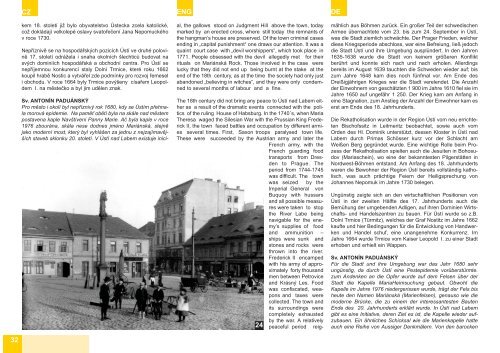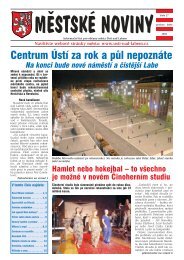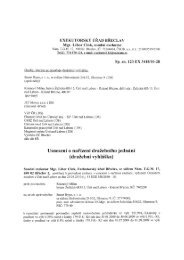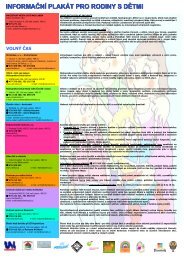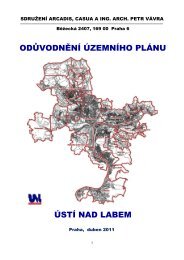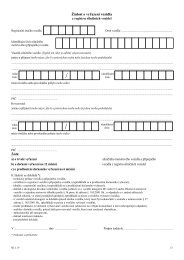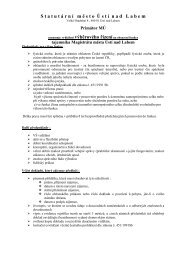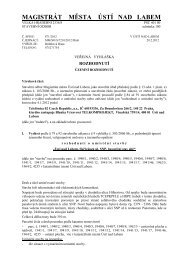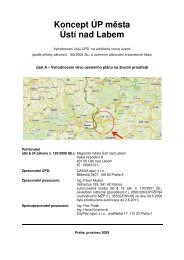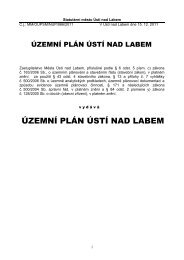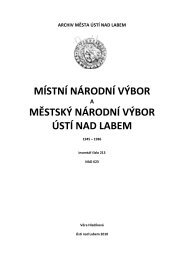Historie a památky města Ústí nad Labem History and monuments of ...
Historie a památky města Ústí nad Labem History and monuments of ...
Historie a památky města Ústí nad Labem History and monuments of ...
Sie wollen auch ein ePaper? Erhöhen Sie die Reichweite Ihrer Titel.
YUMPU macht aus Druck-PDFs automatisch weboptimierte ePaper, die Google liebt.
32<br />
CZ ENG DE<br />
kem 18. století již bylo obyvatelstvo Ústecka zcela katolické,<br />
což dokládají velkolepé oslavy svatořečení Jana Nepomuckého<br />
v roce 1730.<br />
Nepříznivě se na hospodářských pozicích <strong>Ústí</strong> ve druhé polovině<br />
17. století odrážela i snaha okolních šlechticů budovat na<br />
svých dominiích hospodářská a obchodní centra. Pro <strong>Ústí</strong> se<br />
nepříjemnou konkurencí staly Dolní Trmice, které roku 1662<br />
koupil hrabě Nostic a vytvářel zde podmínky pro rozvoj řemesel<br />
i obchodu. V roce 1664 byly Trmice povýšeny císařem Leopoldem<br />
I. na městečko a byl jim udělen znak.<br />
Sv. ANTONÍN PADUÁNSKÝ<br />
Pro město i okolí byl nepříznivý rok 1680, kdy se <strong>Ústí</strong>m přehnala<br />
morová epidemie. Na paměť obětí byla na skále <strong>nad</strong> městem<br />
postavena kaple Navštívení Panny Marie. Ač byla kaple v roce<br />
1976 zbourána, skála nese dodnes jméno Mariánská, stejně<br />
jako moderní most, který byl vyhlášen za jednu z nejzajímavějších<br />
staveb sklonku 20. století. V <strong>Ústí</strong> <strong>nad</strong> <strong>Labem</strong> existuje inici-<br />
al, the gallows stood on Judgment Hill above the town, today<br />
marked by an erected cross, where still today the remnants <strong>of</strong><br />
the hangman’s house are preserved. Of the town criminal cases<br />
ending in „capital punishment“ one draws our attention. It was a<br />
quaint court case with „devil worshippers“, which took place in<br />
1771. People obsessed with the devil allegedly met for their<br />
rituals on Mariánská Rock. Those involved in the case were<br />
lucky that they did not end up being burnt at the stake at the<br />
end <strong>of</strong> the 18th century, as at the time the society had only just<br />
ab<strong>and</strong>oned „believing in witches“, <strong>and</strong> they were only condemned<br />
to several months <strong>of</strong> labour <strong>and</strong> a fine.<br />
The 18th century did not bring any peace to <strong>Ústí</strong> <strong>nad</strong> <strong>Labem</strong> either<br />
as a result <strong>of</strong> the dramatic events connected with the politics<br />
<strong>of</strong> the ruling House <strong>of</strong> Habsburg. In the 1740´s, when Maria<br />
Theresa waged the Silesian War with the Prussian King Frederick<br />
II, the town faced battles <strong>and</strong> occupation by different armies<br />
several times. First, Saxon troops paralysed town life.<br />
These were succeeded by the Austrian army <strong>and</strong> later the<br />
French army, with the<br />
French guarding food<br />
transports from Dresden<br />
to Prague. The<br />
period from 1744-1745<br />
was difficult. The town<br />
was seized by the<br />
Imperial General von<br />
Buquoy with hussars<br />
<strong>and</strong> all possible measures<br />
were taken to stop<br />
the River Labe being<br />
navigable for the enemy’s<br />
supplies <strong>of</strong> food<br />
<strong>and</strong> ammunition –<br />
24<br />
ships were sunk <strong>and</strong><br />
stones <strong>and</strong> rocks were<br />
thrown into the river.<br />
Frederick II encamped<br />
with his army <strong>of</strong> approximately<br />
forty thous<strong>and</strong><br />
men between Petrovice<br />
<strong>and</strong> Krásný Les. Food<br />
was confiscated, weapons<br />
<strong>and</strong> taxes were<br />
collected. The town <strong>and</strong><br />
its surroundings were<br />
completely exhausted<br />
by the war. A relatively<br />
peaceful period reig-<br />
mählich aus Böhmen zurück. Ein großer Teil der schwedischen<br />
Armee übernachtete vom 23. bis zum 24. September in <strong>Ústí</strong>,<br />
was die Stadt ziemlich schwächte. Der Prager Frieden, welcher<br />
diese Kriegsperiode abschloss, war eine Befreiung, ließ jedoch<br />
die Stadt <strong>Ústí</strong> und ihre Umgebung ausplündert. In den Jahren<br />
1635-1638 wurde die Stadt von keinem größeren Konflikt<br />
berührt und konnte sich nach und nach erholen. Allerdings<br />
bereits im August 1639 tauchten die Schweden wieder auf; bis<br />
zum Jahre 1648 kam dies noch fünfmal vor. Am Ende des<br />
Dreißigjährigen Krieges war die Stadt verelendet. Die Anzahl<br />
der Einwohnern von geschätzten 1 900 im Jahre 1610 fiel sie im<br />
Jahre 1650 auf ungefähr 1 250. Der Krieg kam am Anfang in<br />
eine Stagnation, zum Anstieg der Anzahl der Einwohner kam es<br />
erst am Ende des 18. Jahrhunderts.<br />
Die Rekatholisation wurde in der Region <strong>Ústí</strong> vom neu errichteten<br />
Bisch<strong>of</strong>ssitz in Leitmeritz beobachtet, sowie auch vom<br />
Orden des Hl. Dominik unterstützt, dessen Kloster in <strong>Ústí</strong> <strong>nad</strong><br />
<strong>Labem</strong> durch Primas Schösser kurz vor der Schlacht am<br />
Weißen Berg gegründet wurde. Eine wichtige Rolle beim Prozess<br />
der Rekatholisation spielten auch die Jesuiten in Bohosudov<br />
(Mariaschein), wo eine der bekanntesten Pilgerstätten in<br />
Nordwest-Böhmen entst<strong>and</strong>. Am Anfang des 18. Jahrhunderts<br />
waren die Bewohner der Region <strong>Ústí</strong> bereits vollständig katholisch,<br />
was auch prächtige Feiern der Heiligsprechung von<br />
Johannes Nepomuk im Jahre 1730 belegen.<br />
Ungünstig zeigte sich an den wirtschaftlichen Positionen von<br />
<strong>Ústí</strong> in der zweiten Hälfte des 17. Jahrhunderts auch die<br />
Bemühung der umgebenden Adligen, auf ihren Dominien Wirtschafts-<br />
und H<strong>and</strong>elszentren zu bauen. Für <strong>Ústí</strong> wurde so z.B.<br />
Dolní Trmice (Türmitz), welches der Graf Nostitz im Jahre 1662<br />
kaufte und hier Bedingungen für die Entwicklung von H<strong>and</strong>werken<br />
und H<strong>and</strong>el schuf, eine unangenehme Konkurrenz. Im<br />
Jahre 1664 wurde Trmice vom Kaiser Leopold I. zu einer Stadt<br />
erhoben und erhielt ein Wappen.<br />
Sv. ANTONÍN PADUÁNSKÝ<br />
Für die Stadt und ihre Umgebung war das Jahr 1680 sehr<br />
ungünstig, da durch <strong>Ústí</strong> eine Pestepidemie vorüberstürmte.<br />
zum Andenken an die Opfer wurde auf dem Felsen über der<br />
Stadt die Kapelle MariaHeimsuchung gebaut. Obwohl die<br />
Kapelle im Jahre 1976 niedergerissen wurde, trägt der Fels bis<br />
heute den Namen Mariánská (Marienfelsen), genauso wie die<br />
moderne Brücke, die zu einem der interessantesten Bauten<br />
Ende des 20. Jahrhunderts erklärt wurde. In <strong>Ústí</strong> <strong>nad</strong> <strong>Labem</strong><br />
gibt es eine Initiative, deren Ziel es ist, die Kapelle wieder aufzubauen.<br />
Ein ähnliches Schicksal wie die Marienkapelle hatte<br />
auch eine Reihe von Aussiger Denkmälern. Von den barocken


